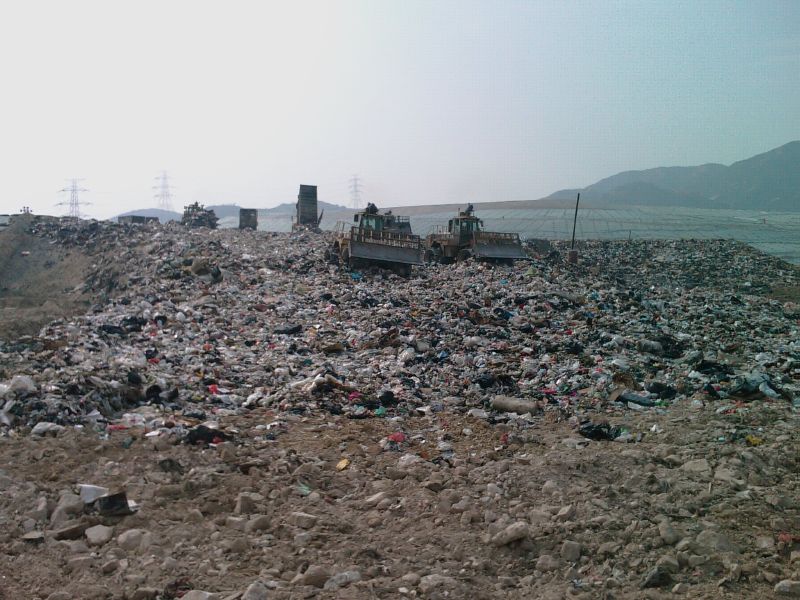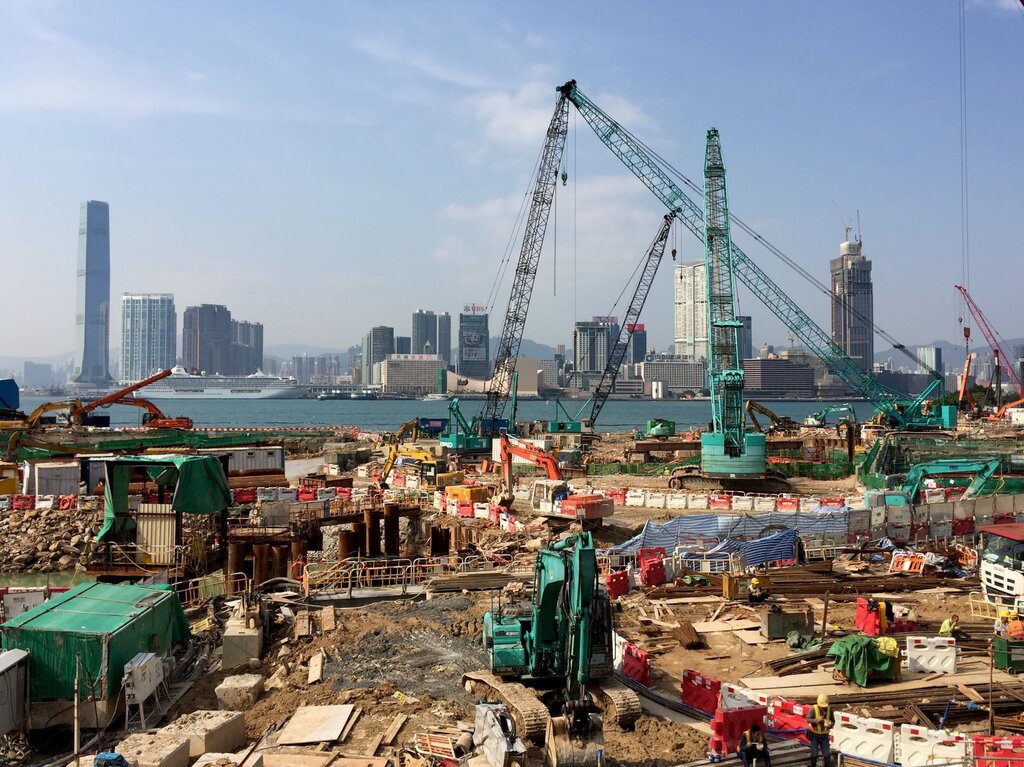Following the latest IPCC report published in March, warning that we are running out of time to limit global warming to 1.5C, the climate crisis is accelerating at a pace like never before. From deforestation to plastic pollution, several factors are causing the exacerbation of climate change. As part of Earth.Org’s ‘Environmental Issues’ series, here are some of the biggest ones Hong Kong faces in 2024.
—
Biggest Environmental Issues in Hong Kong
1. Outdoor Air Pollution
One of the top environmental issues in Hong Kong is air pollution. According to a 2022 study of global mortality and pollution levels published in The Lancet Planetary Health journal, 9 million people around the world die from outdoor air pollution every year. Long-term exposure to severe air pollution also poses serious health problems ranging from chronic respiratory infections and diseases to increased risk of cancer.
Based on Hong Kong Air Quality Health Index (AQHI) records, street-level air pollution in densely populated areas including Causeway Bay, Central and Mong Kok often exceed WHO guidelines, reflecting a sizeable number of Hong Kong residents breathing in air that contains high levels of pollutants every day.
Causes of air pollution in Hong Kong derive from sources like fossil fuel motor vehicles and regional smog, which is caused by pollutants from marine vessels and industrial power plants within the city and from mainland China.
Though the Hong Kong government has announced plans to reach carbon neutrality by 2050, the current rate of carbon emissions shows no signs of slowing down. As for 2021, the number of private motor vehicles registered in Hong Kong reaches up to 657,000, nearly 30,000 more vehicles compared to the previous year. Despite being home to one of the best public transportation systems in the world, Hong Kong residents still heavily rely on private cars when commuting in the city and that proportion continues to grow with each passing year. Within the past decade, the volume of private cars has increased by almost a third, contributing massive amounts of carbon emissions in the city.
You might also like: 10 Facts About Air Pollution That’ll Take Your Breath Away
While the government has made efforts to regulate emissions from industrial power plants and marine vessels that pass through our waters, smog from the Pearl River Delta region has proven difficult to control. Collaboration efforts with Guangdong authorities have been made in improving air quality in the Great Bay Area region, but improvements in air quality have yet to be seen.

One of three strategic landfill sites in Tuen Mun, Hong Kong. Photo: Edwin Lee/Flickr.
2. Landfill Waste
One of the most glaring environmental issues Hong Kong currently faces is landfill waste. Every year, about 4.17 million tonnes of solid waste make its way to our landfills, and during to the coronavirus pandemic, local waste has exponentially grown thanks to the increased use of food takeout boxes, plastic cutleries and single-use masks. Landfill gases, which are emissions from landfills decompose organic waste, will continue to surge as a result and contribute towards global warming, especially when you consider 40-60% of landfill emissions are methane gases, and have 10 times the warming potential than carbon dioxide.
As one of the most densely populated cities in the world with a population of almost 7.5 million people, Hong Kong is in an immensely difficult position to create new dedicated landfills sites. Reducing and recycling waste is the only viable long term solution in dealing with the city’s insurmountable landfill waste problem. And while the Waste Charging Scheme passed by the Legislative Council in late 2021 – 16 years after it was first proposed – is a good first step, much more is needed to tackle the issue.
More on the topic: Can the Municipal Waste Charging Scheme Help With Waste Reduction in Hong Kong?
3. Plastic Pollution
Even before the coronavirus pandemic, Hong Kong generate about 3.9 billion disposable food and drink containers every year. This amounts to 170 takeaway meals and 180 disposal drinks for every Hongkonger. As restaurants limit opening hours and seating capacities during the pandemic, people rely on takeaway options and the amount of plastic containers and cutleries used and disposed of has only soared. In 2020, plastics made up 21% of the city’s total municipal solid waste (MSW), accounting for the third-largest share of MSW after food waste and paper. The city’s beaches and waterways are drowning in plastic, and microplastic levels in the sea are 40% higher than the global average. According to estimates, more than 5,000 pieces of microplastic can be found in every square metre of sea.
Some F&B companies have made the effort to adopt biodegradable and even compostable takeaway packaging and utensils, but a majority of local restaurants and small businesses still opt for low-cost materials like styrofoam.
The lack of an efficient recycling infrastructure is a major contributing factor in the plastic crisis in Hong Kong. In 2019, less than 20% of plastic packaging waste was recycled due to the lack of adequate recycling facilities. Prior to China’s Waste Ban, where the country placed a ban on importing unprocessed materials, Hong Kong used to offload the city’s rubbish to the mainland for recycling. Since the policy implementation, Hong Kong has yet developed enough recycling plants to compensate. While some government interventions such as the Plastic Recycling Pilot Scheme seem to be working, as Hong Kong experienced a 27% increase in locally recycled plastics in 2020, plastic problem is still haunting the city.
You might also like: China’s Refusal to Take Back Food Containers Exposes Hong Kong’s Broken Plastic Waste Management System
4. Food Waste
Known as an international food paradise, Hong Kong has a reputation for affordable and a stunning variety of international cuisines. Consequently, this means that food waste is equally high in the city and without a doubt one of the biggest environmental issues that Hong Kong faces.
Food waste in Hong Kong accounts for about 30% of municipal solid waste that goes straight to landfills. In 2019, a recorded 1,067 tonnes of food waste were produced from commercial and industrial sources such as restaurants, hotels and wet markets. The amount of food waste has also been on the rise especially in the F&B industry where it grew from 800 tonnes per day in 2012 to 1,000 tonnes of waste generated per day in 2019.
While the government has introduced educational initiatives and an operating organic waste recovery center OPARK, over 3,600 tonnes of food waste are still being sent to Hong Kong’s landfills each day, contributing to over hundred thousand tonnes of greenhouse gases to the atmosphere.

Land reclamation site for Central piers, Hong Kong. Photo: Piqsels.
5. Biodiversity Loss
Hong Kong has surprisingly rich biodiversity thanks to its large natural terrain and coastal waters. In fact, 40% of the city’s land belongs to country parks and protected areas, which supports more than 3,300 species of vascular plants, 57 species of terrestrial mammals, and more than 540 species of birds. Our waters also support over 1,000 species of fishes, too.
However, in order to make space for the city’s already dense and growing population, Hong Kong has devoted much effort in urbanisation and land reclamation. Land development, be it deforestation or illegal waste dumping, is one of the growing environmental issues be in Hong Kong, and has led to significant impacts to the local biodiversity and habits.
The pink dolphin, also known as the Chinese white dolphin, is a prime example of how local species are threatened by continued land development. The waters surrounding Hong Kong have been part of the dolphins’ habitat for centuries, with recorded sightings going back to the Tang Dynasty. The number of pink dolphins that frequent Hong Kong coastlines has dropped to about 300 in recent years due to heavy vessel traffic and most importantly, its shrinking habitat. The development of the Chek Lap Kok island, which is home to the Hong Kong International Airport, and the associated land reclamation have reduced the amount of fish dolphins can eat while dredging has unearthed pollution from the seafloor causing water pollution. A massive 1,700 hectares land reclamation plan near the easter waters of Lantau Island that was proposed in 2018 will further deteriorate the dolphin habitat as well as increase vulnerabilities to rising sea levels.
You might also like: ‘The Oyster Odyssey’: A Journey to Restore Hong Kong’s Coastal Ecosystems
Another serious threat to Hong Kong biodiversity is illegal wildlife trafficking. The city is home to one of the largest hubs for the illegal wildlife trafficking industry thanks to its free ports, geographical location in the Greater Bay Area and accessibility to other Asian countries. Every year, the city sees millions of live animals and their derivatives pass through its ports. In 2019 alone, more than 7,000 endangered animals were illegally traded in the city, including pangolins and live turtles. However a landmark bill was passed in August 2021 which will treat illegal wildlife trading and seizures as a serious crime while placing greater attention on organised criminals and networks instead of carriers and mules. The passage of the amendment aims to deter smuggling operations and supply networks in the city.
6. Water Pollution
Hong Kong is a unique city surrounded by the South China Sea, where marine waters cover about 1700 km² and home to a wide range of different marine environments. In the early 1970s and 80s, most of the city’s sewage and wastewater were discharged into the sea, with little to no treatment. As a result, Hong Kong waters experienced a surge in organic and inorganic pollutants, a reduction of oxygen content, and increased bacteria levels. By 2005, Hong Kong generated about 2 million tonnes of wastewater as well as industrial effluents every day, making it one of the main sources of water pollution in Hong Kong.
Marine pollution has also been exacerbated by the COVID-19 pandemic as an additional 4,680 to 6,240 metric tonnes of marine plastic waste made its way into the Hong Kong waters. An estimated 1.56 billion face masks were dumped into the ocean during this period, which experts have said will take as long as 450 years to break down. Microplastics from single-use masks are also incredibly harmful to marine life and the ecosystem, potentially killing up to 100,000 marine mammals and turtles, and over a million seabirds.
You might also like: 15 Biggest Environmental Problems Of 2024


















